#large-flowered sneezeweed
Video
n380_w1150 by Biodiversity Heritage Library
Via Flickr:
Wild flowers of New York. Albany,University of the State of New York,1918. biodiversitylibrary.org/page/40798423
#New York (State)#Pictorial works#Wild flowers#New York Botanical Garden#LuEsther T. Mertz Library#bhl:page=40798423#dc:identifier=https://biodiversitylibrary.org/page/40798423#flickr#sneezeweed#swamp sunflower#small rose#pink tickseed#helenium autumnale#large-flowered sneezeweed#coreopsis rosea#coreopsis#tickseed#botanical illustration#scientific illustration
11 notes
·
View notes
Text

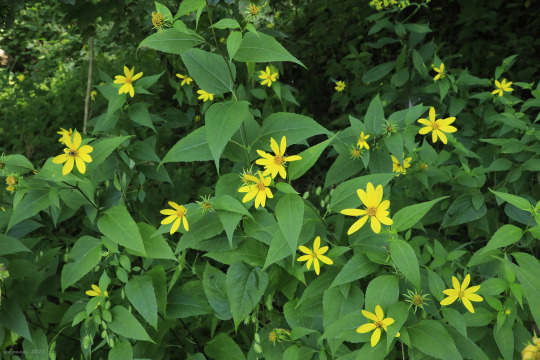

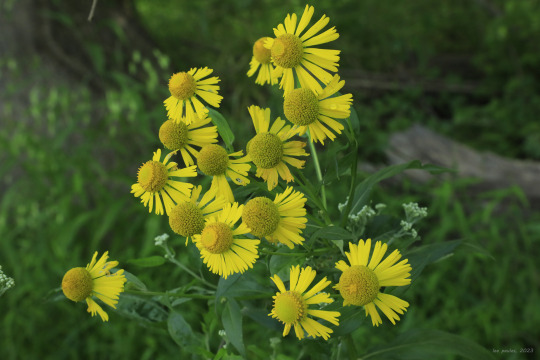
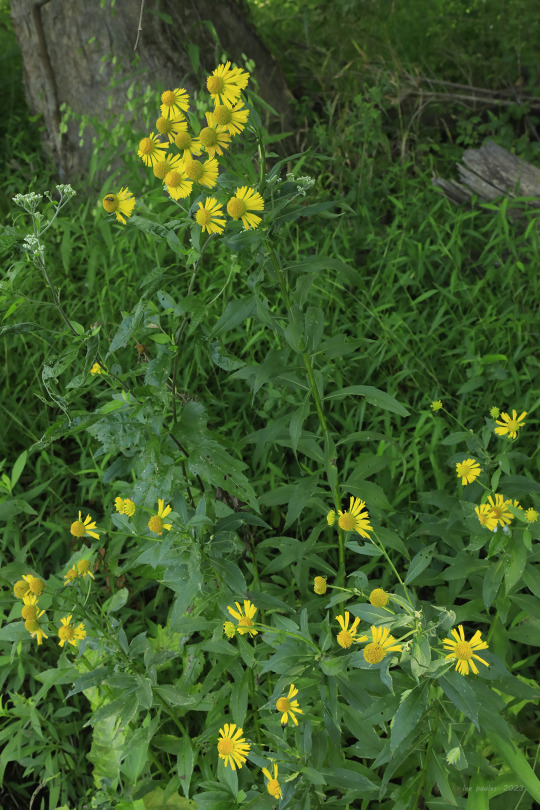

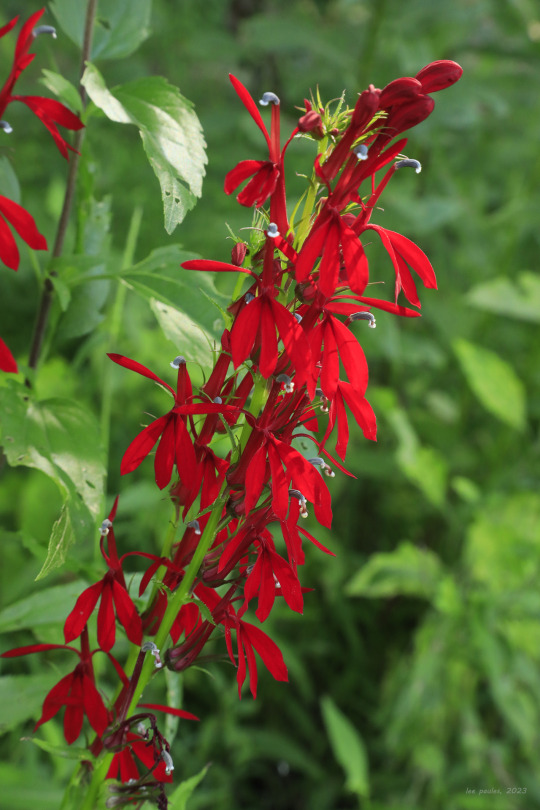

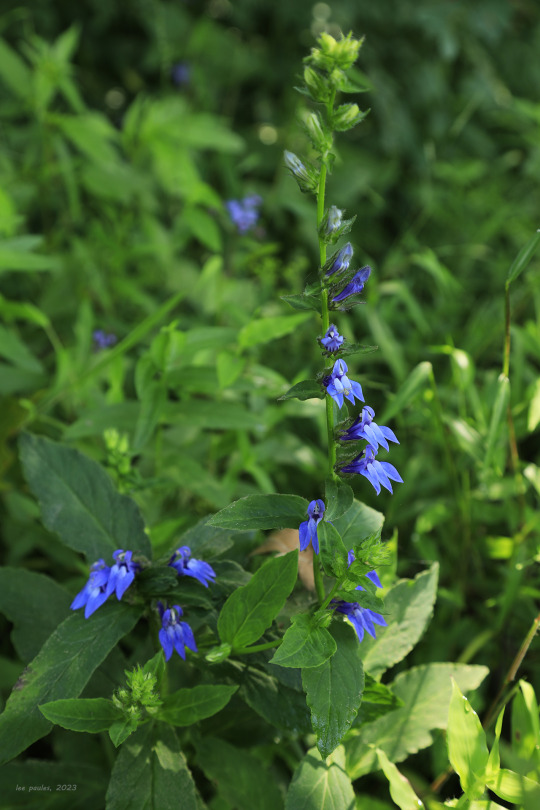

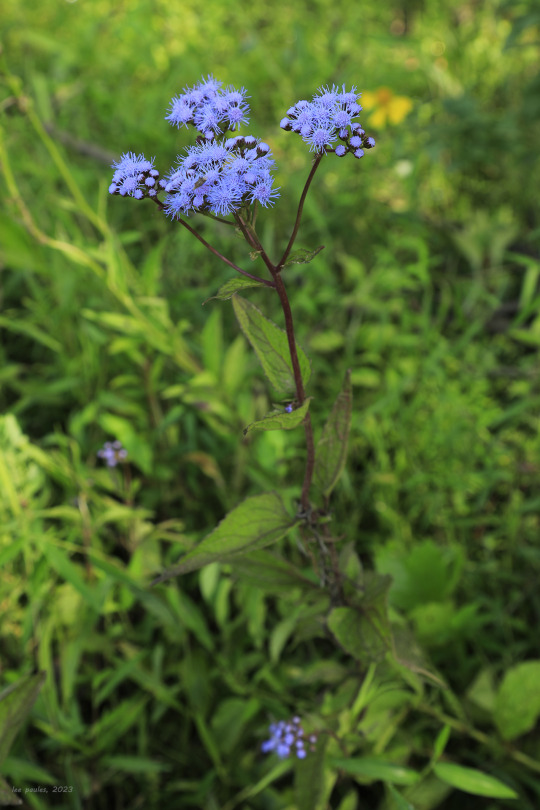
A selection of late summer wildflowers growing in the riparian zone along the Monongahela River at the Friendship Hill National Historic Site.
From top: Paleleaf woodland sunflower (Helianthus strumosus), also known as pale-leaved sunflower, distinguished by long leaf petioles and a pale leaf underside; common sneezeweed (Helenium autumnale), a water-loving aster whose dried leaves were once used to make snuff; cardinal flower (Lobelia cardinalis), whose scarlet, five-lobed flowers draw hummingbirds as pollinators; the closely-related great blue lobelia (Lobelia siphilitica), which early settlers once used as a treatment for syphilis (wishful thinking); and blue mistflower (Conoclinium coelestinum), or wild ageratum, a native aster that has become popular as a garden plant.

As a note, about a dozen sunflowers call NC-WV - SW PA home and they readily hybridize, often complicating identification. Pale-leaved sunflower has a tall, branching structure up to 7 feet in height and dense clusters of large flowers. In addition to long petioles and a pale leaf underside, this sunflower has a smooth stem with a whitish bloom to it. It's a very beautiful mid-to-late summer aster and one of my favorite wildflowers of Central Appalachia.
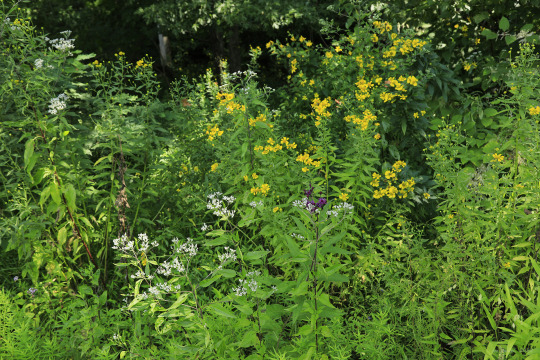
#appalachia#vandalia#wildflowers#flora#summer#pennsylvania#monongahela river#friendship hill national historic site#pale-leaved sunflower#paleleaf woodland sunflower#paleleaf sunflower#common sneezeweed#cardinal flower#great blue lobelia#blue mistflower#mistflower#wild argeratum#riparian
131 notes
·
View notes
Text


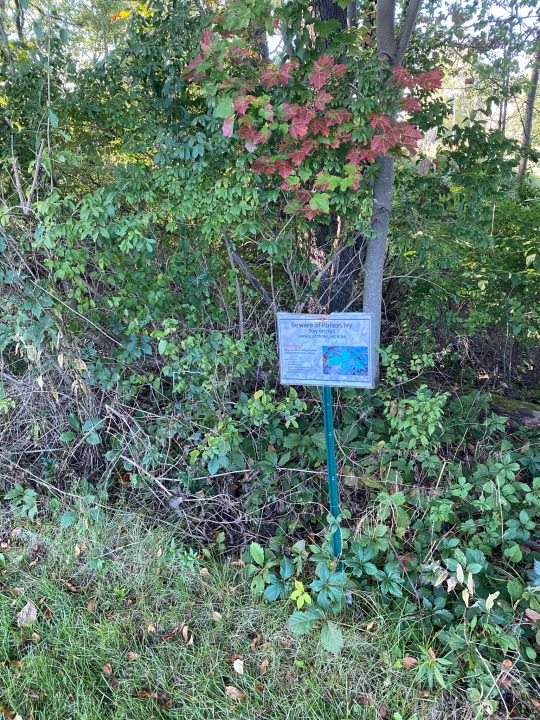
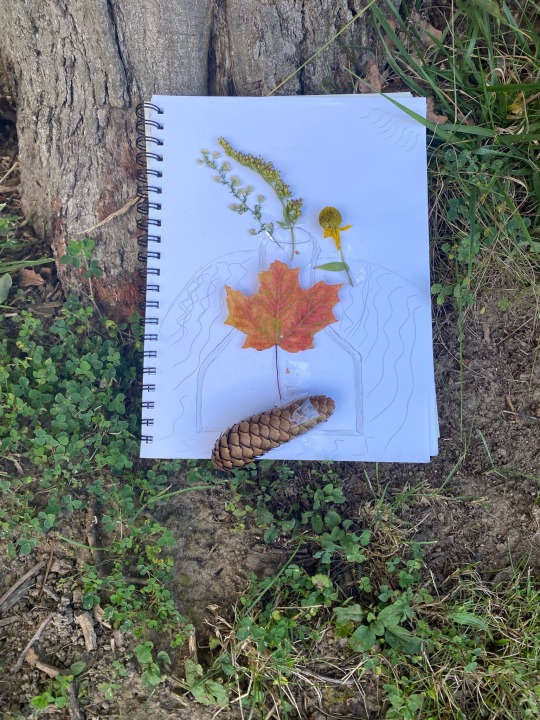
Sugar Maple (large orange leaf)- the sugar maple is the primary source of maple syrup. Seeds from the sugar maple tree have to be exposed to 45 days of temperatures below 39° in order to break their protective coating to germinate.
Helenium autumnale (yellow bulbous flower)- Also known as common sneezeweed. Common sneezeweed does not cause seasonal allergies, despite its name, which comes from the leaves of the plant being used in snuff to cast out evil spirits.
Lance-leaved aster (skinny plant with white flowers)- This plant was introduced into parts of Europe, where its production of chemicals causes harm to other plants and has been named an invasive species. Aster has been used by indigenous tribes to treat wounds, nosebleeds, and fevers.
“Lead white May have helped the painted occupant of the Goguryeo tomb remain fresh, but then he was already dead. The pigment has seldom been a friend to the living” (pg 46).
I thought that this passage was interesting because it never occurred to me that lead paint had been around for so long. When I think of lead paint I think of houses that were painted using lead paint and it feels like more a recent discovery than being used in the B.Cs. I also found it interesting that even though all these people that were using lead paint and wearing lead-based makeup kept dying, there was no movement to stop the use of lead based products.
6 notes
·
View notes
Text
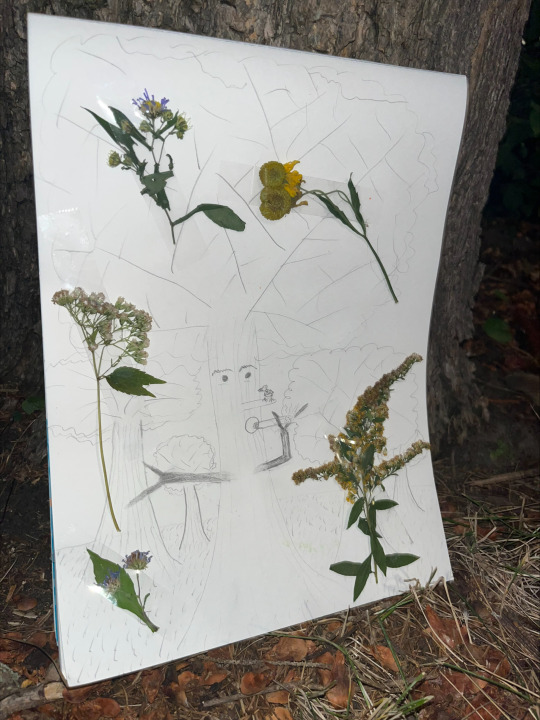



Plants:
Goldenrods -- A perennial species native to North America. They typically grow in open areas like meadows.
Common Sneezeweed -- A flowering plant in the sunflower family native to North America. Common names include sneezeweed and large-flowered sneeze weed.
Crookedstem Aster -- Native to eastern North America, this flowering plant in the aster family can be found almost exclusively in the eastern U.S. and Canada.
Attendance Prompt #2:
"Most children will, at some stage, try mixing all their favorite paints together expecting to make an extra-special color. They will gather fire-engine red, sunny-sky blue, and perhaps some Care Bear pastels and begin stirring. That such a mixture results not in something beautiful but in an irretrievably murky dark gray is one of life’s first hard truths." (43-44)
This passage reminded me of the saying "quality over quantity." Sometimes we try to stuff too many things onto our palettes, or into our lives. Although often born out of good intentions, taking on too many things at once leads to a sub-optimal result.
3 notes
·
View notes
Text


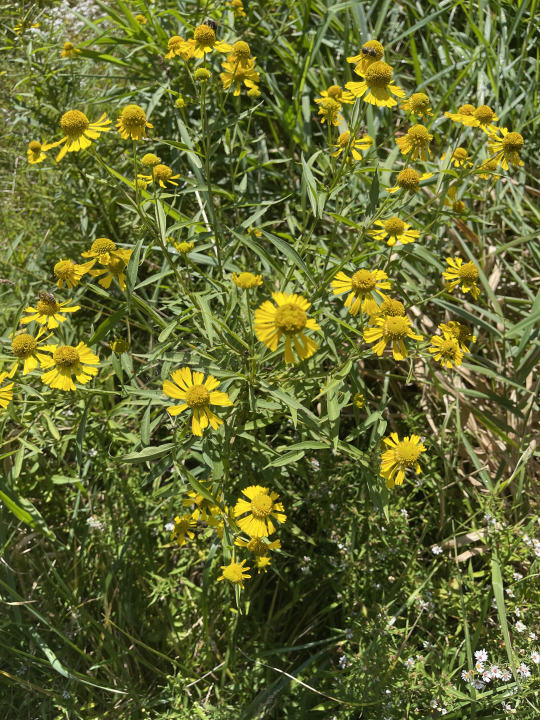

I went on my walk behind campus on the Allegany River Trail!
Common Sneezeweed (yellow) - This flower is native to North America. It has been used as a snuff which causes individuals to sneeze witch supposedly casts out the evil spirits. The plant is poisonous to many animals including dogs and cows. Sneezeweeds have been known to cause cows to have bitter milk.
Balsam Fi (green on left) - Most often found in Canada and the Northeast United States. Native Americans used Fi for medical purposes for several years.
The large plant in the middle of my paper I was unable to identify. My best guess is a type of Scaldweed but I am not 100% sure.
Attendance:
On page 40 of The Secret Lives of Color the quote about the color white representing wealth was something I was unaware of before. “ White has long been intricately connected with money and power. Fabrics, including wool and cotton, had to be heavily processed in order to appear white. Only the very wealthy, supported by battalions of staff, could afford to keep the fresh lace and linen cuffs, ruffs, and cravats worn in the sixteenth, seventeenth and eighteenth centuries pristine. This connection still holds true.” This made me think about how today we often take for granted the colors we have available to us both in clothing choices and paint. We can easily go to the store and pick up the color white paint or go to the store and buy a white dress. Its easy to forget how long it took us to get to a point of being able to easily produce not just white but all colors.
3 notes
·
View notes
Text
TIL that the chemical compound helenalin is a sternutatory substance found in plants of the genus Helenium, aka sneezeweeds. It is a sesquiterpene lactone that irritates the mucous membranes. The pollen of Helenium plants doesn't do much, since it is spread by insects and has grains too large to be carried on the wind. Most of the helenalin is in the leaves and flowers of the plants, which historically were dried by Native Americans and ground into a snuff that was used to induce sneezing.
You know, I've been looking for plants that are native to my area to incorporate into my garden, and Helenium autumnale is distributed across most of North America...
... However, I feel it would be irresponsible if I did not add: helenalin is a toxin. It irritates your mucous membranes — this includes your gastrointestinal system! It can cause nausea, vomiting, diarrhea, and internal bleeding. It also can cause acute liver toxicity and suppress your immune system. If applied to the skin, it can cause contact dermatitis. If enough is ingested, you can die.
That being said, helenalin concentrations in Helenium plants are low, about 0.5%-3% by dry weight, with the highest concentration being in the flowers. Toxicity in humans is not well studied, but lethal doses in other mammals have been shown to range from around 85-105 mg/kg when taken orally. Basically, don't have a sneezeweed salad, and don't start mainlining pure helenalin. If you do try using it, do so at your own risk.
8 notes
·
View notes
Text
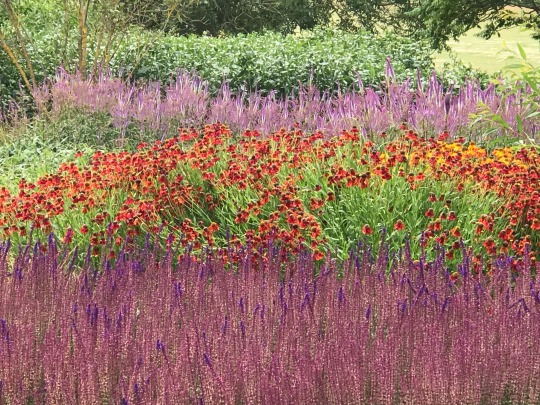
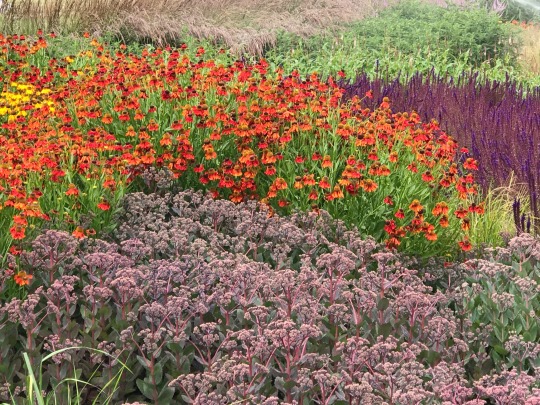



Plant of the Day
Sunday 12 July 2020
The flowering herbaceous perennials in these large island beds seem like giant brushstrokes of paint on the landscape. The red-orange of Helenium 'Moerheim Beauty' (sneezeweed), the pink of Veronicastrum virginicum 'Fascination' (Culver's root) and the yet to fully open Hylotelephium (sedum, stonecrop) flowers with the purple of Salvia nemorosa 'Caradonna' (Balkan clary).
Jill Raggett
#helenium#sneezeweed#salvia#Balkanclary#Hylotelephium#stonecrop#sedum#Veronicastrum#Culver’sroot#pinkflowers#purpleflowers#orangeflowers#herbaceousperennial#herbaceous#perennial#islandbeds#rhshydehall#hydehall#plants#writtledesign#mhort#gardens#horticulture#garden
244 notes
·
View notes
Note
Fluffy eskel during a fun autumn day (pumpkin carving, chai tea, mountain trail walks, knitting big fluffy sweaters, baking, whatever you want!)
A/N: I want to do a few more fall/Halloween-ish prompts!! This was absolutely so much fun!!
***
Kaer Morhen’s usual gloomy and decrepit atmosphere was replaced with something more lively, more welcoming.
You hummed as you moved around the kitchen, taking advantage of the large stone ovens meant to cook enough food for all the young witchers-to-be that had once lived in the keep. There were three pies in one oven, heated by a flame Eskel kept strong.
You turned to cross the room, wanting to finish making the crust for the final gooseberry pie. You turned so suddenly you didn’t have time to react. You ran into Eskel and almost fell. But his strong hands caught you, one gripping your arm and the other your hip.
“Easy there, doll.” He chuckled softly, his grip loosening on you once he was sure you weren’t going to fall.
“Sorry.”
“No worries. But, uh, I think I got a little flour on you.” Eskel rubbed your arm and then moved to get a better look at your side.
“It’s okay. I have to get a bath later anyways. I think there’s flour and spices all over me.”
As you went to the table where the pie dough was, you looked over to Lambert and Ciri. They sat on the floor near the hearth, carving nearly a dozen pumpkins together.
Lambert was taking his pumpkin carving very seriously. He took his time to cut each triangle shaped eye and squared tooth into the pumpkin.
Ciri was being a little more carefree, but she still tried her best. She was working on cleaning out her third pumpkin when she accidentally flung a spoonful of pumpkin seeds and pulp on to Lambert.
“Hey, you ass!” The witcher called, wiping the orange stringy pulp and slimy seeds from his hair.
“Sorry, Lamb- Ah!” Ciri shouted as Lambert threw a handful of the pulp at her. This sparked a war.
You sighed, shaking your head as you started to knead the dough.
“Guys! That’s enough!” Yennefer called, brushing the pulp off of her skirt. “I don’t want to smell like a pumpkin.”
“You’re such a killjoy, Yenn.” Lambert rolled his eyes.
“You’re nearly a century old, Lambert. Grow up.”
“That’s why you’re so boring.”
Yennefer chose to ignore the witcher and instead, she focused on the decorations she and Geralt were working on. They were putting together centerpieces for the table. The center pieces consisted of goldenrods, sweet alyssums, sneezeweeds and various other flowers.
Your gaze fell on the eldest witcher, who stood at a table on the other side of the room. He was cleaning a boar he and Lambert had hunted down earlier that morning.
A smile came to your lips, seeing everyone gathered in the same room making preparations for tonight’s dinner.
Thick arms snaked around your waist, pulling you from your thoughts.
“What are you thinking about?” His breath was warm against your neck.
“I’m just…. I’m really happy everyone is having fun.” You smiled.
“Speak for yourself.” Lambert grunted. “I’m in hell right now. I’m never going to stop smelling like pumpkin and I swear, I’m going to vomit the next time this demon throws this shit at me.”
Ciri smirked.
“Don’t let him fool you, Y/N.” Eskel pressed a kiss to the side of your head. “He’s having fun. Wouldn’t be doing it if he wasn’t.”
“I didn’t think anyone would take me seriously whenever I suggested we do something like this.”
“I think…. I think we all were a little skeptical.” Eskel moved away from you to stand next to you, that way you could continue working on the dough and he wouldn’t be a distraction. “We’ve never done this. None of us have.”
“I’m glad I could talk you guys into it.” You gave him another hearty smile.
“All that talking isn’t going to get those pies done, Y/N.” Lambert teased. The pumpkin in his lap exploded, sending orange debris in every direction, but mostly covering the witcher.
Your eyes flickered over to Yennefer, who was laughing quietly to herself.
“Fuck.” The young wolf cursed, wiping the slime from his eyes.
“Poor Lambert has to get a bath.” You faked a frown.
“Two baths in one week? I think that’s a new record.” Geralt chuckled.
“Yeah, yeah. Pick on the youngest.” Lambert muttered, picking up another pumpkin and placing it on his lap.
“I’m going to go see if Vesemir needs any help.” Eskel told you, putting his hand on the small of your back and kissing your head.
You watched him walk across the room, a smile lingering on your face.
You’d never been more happy than you were in that moment. Your family was together in one room, working together, smiling and laughing and joking.
Across the room, Eskel began to help Vesemir with the boar. The dark haired witcher’s eyes found yours and a little smile came to his scarred lips.
“I love you.” You mouthed the words, hoping he’d be able to tell what you were saying.
The widening of his smile told you that he knew.
Taglist: @pressedinthepages @mishafaye @whitewolfandthefox @wolfyland07 @belalugosisdead @persephonehemingway @keira-hulmaster @dinonuggs69 @greatestauthorofmygeneration @shadow-hunters-lover @dancingwith-thesunflowers @tedi-fach-las @thecomfortofoldstorries @raspberrydreamclouds @natkowaa @disasteren @weathervanes-my-oneandlonely @onlyhenrys @wackylurker @criminaly-supernatural @magpie343 @permanently-exhausted-witcher @hina-chans-stuff @the-space-between-heartbeats @havenoffandoms @carriebee1 @ger-bearofrivia @naominami @writingawaymylife @reaganjenelle @theawkwardpedestrian @scarlettwitcher @badassspaceprincess @just-a-sad-donut @summersong69 @an–actual–human–disaster @rubyqueen819 @omgkatinka @c-a-v-a-l-r-y @vonxcon @mazakeen @bravelittlesunflower @thereagles @awkward-turtles-world @menalliha @cotton_mo @maan24 @she-wolfoftheinquisition @titaniafire
88 notes
·
View notes
Text

The month since the last bloom day, that is, from 16 Aug. to 15 Sept., has definitely brought a shift from high summer to nascent fall. Temperatures ranged from highs of 88F to 66F (average of 77 over 31 days), and lows from 42-65F (average of 52.6 over 31 days). This last week we’ve experienced a high of 86F one day, four days that hit the low 70s, and two days that reached only the high 60s. I can see low temperatures in the 30s coming up in the 10-day forecast. Most significantly, I switched from skorts to pants about a week ago, and we had our first woodstove fire of the season last night.
*
Peach time came and went, a short season from about 20 Aug. until 7 Sept., during which time we picked about 600 peaches that were “keepers,” fewer than last year but most of these were bigger and less blemished. The best ones we ate for breakfast, lunch, dinner, and snacks, and gave away to friends and neighbours; those that had some damage (but were mostly fine) became peach pie (2 pies), peach cobbler bread (12 loaves), and dried peach slices. And now the peach trees are bare again.
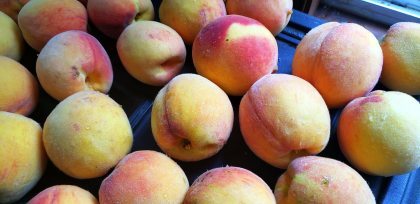
*
The blooms that shine in my early September garden include:
EUTROCHIUM purpureum (Joe Pye weed), still going strong and attracting the lion’s share of the butterflies.
*
a variety of SEDUMS (stonecrop), including Autumn Fire, Autumn Joy, Hab Grey, and Turkish Delight
*
GOLDENROD (Solidago spp; volunteers all), shown with holly, phlox, hydrangea
*
KIRENGESHOMA palmata (yellow waxbells). Frankly, one plant is not a show stopper; you wouldn’t notice mine if you weren’t looking for it. But it’s one of my favourite perennials, even though it’s yellow, because of its unusual leaves and flowers.



*
HELENIUM autumnale (sneezeweed), reblooming from a Botanical Interests’ “Bring Home the Butterflies” seed mix of several years ago


*
PHLOX
*
GENTIANA asclepiadea (willow gentian)
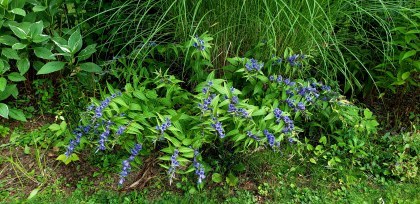
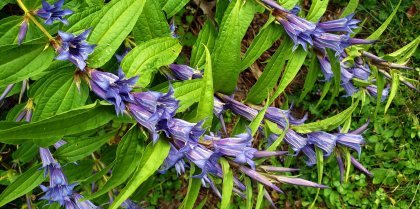


*
CLETHRA alnifolia ‘Ruby Spice’ (summersweet)
*
HYDRANGEAS (mostly PeeGee)





*
BUDDLEIA davidii ‘Ellen’s Blue’ (butterfly bush)
*
CHELONE lyonii ‘Hot Lips’ (turtlehead). I love watching bumblebees push their way inside the blooms and emerge covered in pollen.
*
wild ASTERS
*
BONUS: A few more flowers I’m fond of right now:
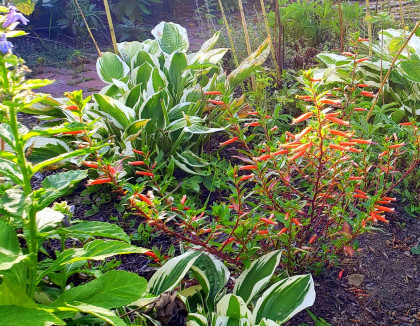
Vermillionaire – large firecracker plant (a cuphea hybrid) , an annual, with some ‘Patriot’ hostas

Anemone tormentosa ‘Robustissima’

Anemone tormentosa ‘Robustissima’ buds

Anise hyssop (Agastache foeniculum)
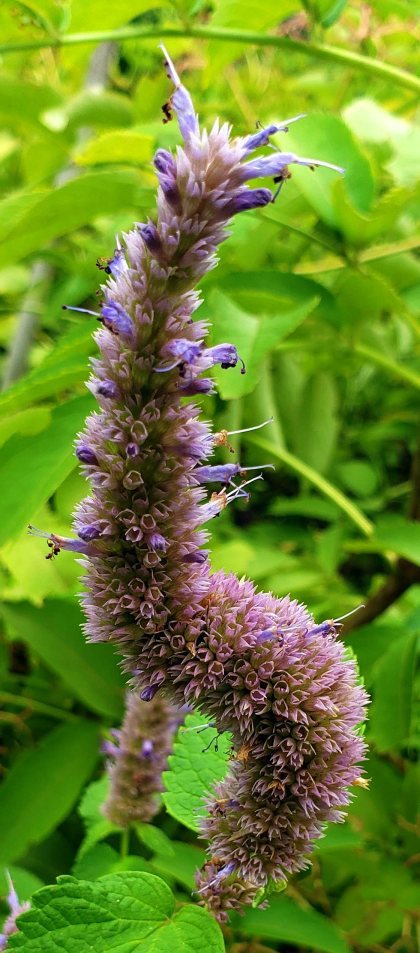
a playfully shaped anise hyssop (Agastache foeniculum)

Perovskia atriplicifolia (Russian sage)

volunteer Lobelia siphilitica (great blue lobelia)
*
I’m not sure what I’ll have to show for October other than a pink aster (can’t recall name) and Aster laevis ‘Bluebird.’
And then there will be only autumn leaves (fall’s true flowers), and after that … snowcover until April.
*
Spent by Mark Doty
“Late August morning I go out to cut
spent and faded hydrangeas—washed
greens, russets, troubled little auras
of sky as if these were the very silks
of Versailles, mottled by rain and ruin
then half-restored, after all this time…
…
In their silvered jug,
these bruise-blessed flowers”
(The whole poem is worth reading, here)
*
Garden Bloggers’ Bloom Day is hosted by Carol at May Dreams Gardens.
September Bloom Day The month since the last bloom day, that is, from 16 Aug. to 15 Sept., has definitely brought a shift from high summer to nascent fall.
#anise hyssop#blooms#buddleia#chelone#clethra#flowers#Garden Bloggers’ Bloom Day#GBBD#gentian#goldenrod#hydrangea#Joe Pye Weed#kirengeshoma#Mark Doty#phlox#sedum#September#summer
3 notes
·
View notes
Photo
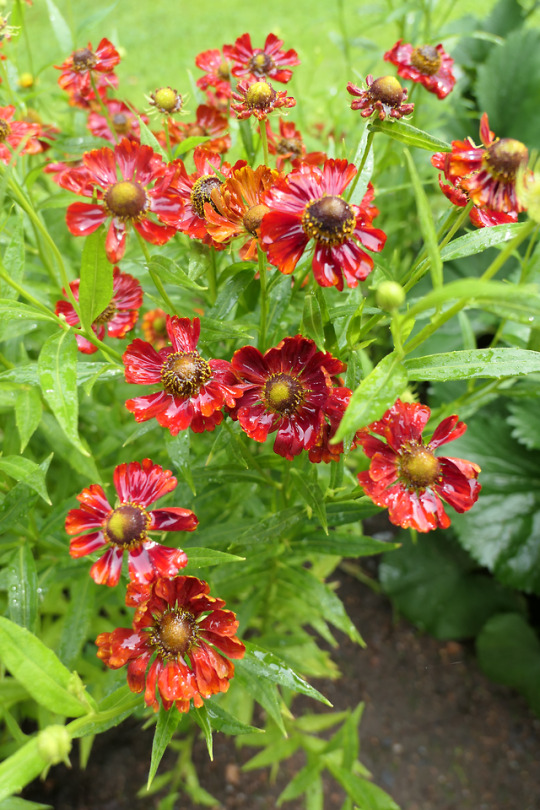
Helenium autumnale — common sneezeweed a.k.a. large-flowered sneezeweed
9 notes
·
View notes
Text
Helenium, or the sneezeweed, flowers from late summer to the middle of fall. It is an herbaceous perennial. There are a variety of cultivars that produce flowers in bright golden, orange-red, and copper-red blooms. these plants are easy to grow and can form large clumps of flowers in your garden.

submitted by /u/Brown_George20
[link] [comments]
Helenium, or the sneezeweed, flowers from late summer to the middle of fall. It is an herbaceous perennial. There are a variety of cultivars that produce flowers in bright golden, orange-red, and copper-red blooms. these plants are easy to grow and can form large clumps of flowers in your garden. published first on https://yeuhoavn.tumblr.com/
0 notes
Text
Planting Your Native Garden
Published: March 22, 2017
Izabella Redlinski, Conservation Ecologist, Keller Science Action Center
You're reading: Planting Your Native Garden
Alert
Before you start (literally) digging in, here’s how you can plan the layout of your native garden.

Read more: Why do you need a Zen garden? – Times of India
If you’re gearing up to add native plants to your yard this spring, congratulations! You’ll make your space more beautiful, with the added bonus of being hospitable to butterflies and other pollinators like bees, beetles, and birds.
Before you dig in, take a moment to plan the layout of the garden (even a small strip of land along a fence will make pollinators happy). Take the following into consideration:
Do you already have natural features in your garden (trees, rose bushes, other annual or perennial plants)? There’s no need to get rid of them; think about planting around the existing landscape in your yard.
How would you describe the area where you wish to plant? Is it sunny or part shade? Wet or dry? Determining this early on in the process will allow you to focus on the species you need. Take note of the moisture and sun exposure each species requires. In general, prairie plants tend to love full sun, savanna plants tolerate some shade, and woodland plants do best in part to full shade.
Are you planting a large area in the middle of your front lawn or a modest spot along a fence or by the garage? This might influence what kinds of flowers you choose. For example, unless you are planting really large areas, do not plant species like prairie dock or compass plant, which can grow over six feet tall. They might visually dwarf the area you are working with. If you do want to create a screen, go for the tall giant ironweed, sneezeweed, and big bluestem. When planting in a circular arrangement, place shorter species on the outside so they’re visible in front of the taller species.
Draw the plan on a sheet of paper. This can include the flower color, height, and time of blooming. A little planning goes a long way: by thinking ahead about some of these factors, you can plan for a garden that lasts throughout the growing season and brings new surprises. It also provides nectar sources for pollinators throughout the whole season.
Read more: Starting a new vegetable patch
Start slowly. Do a few species during the first year, and add more as time goes on. This will allow you to get a sense of where you have “blooming gaps” and understand the true conditions in your garden—it might appear wetter or drier than you previously thought, and the plants might help you determine that.
Cluster flowers and grasses. Groups of five or more individuals of the same species are more successful in attracting pollinators.
Consider certifying your native garden for wildlife, pollinators, or specifically monarchs. This simple sign tells passersby that you are doing something for the environment; it might be a great conversation starter and inspire your community to do likewise. This also puts your garden on a map, quite literally, making it easier for native habitat advocates to push environmentally-friendly legislature.
Pick your native plants by going to local sales. If you need a few ideas, visit our Rice Foundation Native Gardens or check out our guide to monarch-friendly gardens.
Source: https://livingcorner.com.au
Category: Garden
source https://livingcorner.com.au/planting-your-native-garden/
0 notes
Text
Autumn Colour this year and next . . . . .
The season has suddenly changed and everything is feeling beautifully autumnal isn’t it. This is the latest in our series of Guest Blogs, with another great one from Renée Canter, also known as The Girl Who Gardens:
When we think of colour in landscape our thoughts turn immediately to Autumn first. The leaves turning all shades from red through orange to yellow on the trees and then carpeting the ground.
Autumn is nearly here and is actually the best time of year for planting as the soil is warm from the Summer but damper from the cooler Autumn temperatures. So now is a great time to be thinking about what plants or shrubs you could add to your garden to bring you some of that Autumn colour this year and next. Here are 10 of my favourites:
Coneflower (Rudbeckia laciniata ‘Herbstonne’)
These bright yellow daisy-like flowers can reach up to 2m high so are best planted at the back of a bed enmasse to get the full effect. They prefer full sun, flower into September (maybe even October) and might need some support to keep them upright.
Ice Maiden (Sedum spectabile ‘Brilliant’)
This looks like a succulent with its grey-green leaves. Its flat heads of pink flowers is loved by bees and butterflies and they flower from August to November and look great left as seedheads over the Winter, with them only needed to be cut down in March time. This is such an under-rated plant but brings great structure to the garden from May right through to March so works really hard! It’s almost indestructible too and doesn’t mind a bit of shade.
Red Hot Poker (Kniphofia)
These are a 70s classic and I’m on a 1 woman mission to bring them back to our gardens as they are beautiful. There is a huge variety of colours; their tall spikes come in red, orange or yellow and sit high above evergreen strap-like leaves. Plant them in groups of 3s in your borders to give height, impact and a wow factor! They don’t mind a bit of shade and can grow up to 1.3m tall. Just cut back the flower spikes when they get too tatty over Winter.
Sneezeweed (Helenium ‘Moerheim Beauty’)
These dark copper red daisy-like flowers are beautiful when planted in groups. They reach 1.25m high; prefer full sun and baby plants might need some protection from slugs and snails! Any daisy-like flowers will keep on flowering if you deadhead them.
Fountain Grass (Pennisetum alopecuroides)
Grasses have become very fashionable over the last few years and I love the evergreen ones that give interest all year round. This one creates a compact low mound with long-lasting brush like flowers from July onwards. It prefers full sun but all you have to do is remove any dead foliage in the Spring.
Golden Oats (Stipa gigantena)
This evergreen grass can reach 2.5m tall. It grows into clumps of green-grey leaves with arching stems of oat-like flowers from July. This one moves in the wind really gracefully and is stunning in the evening sun. Again it prefers full sun and you just comb through it in the Spring to take out any dead foliage.
Bluebeard (Caryopteris x clandonensis)
This shrub has aromatic grey-green leaves and beautiful lilac-blue flowers from August onwards. It sits beautifully in a mixed border and the bees and butterflies love it. Prune back the growth in the Spring for new growth and flowers that year.
Japanese Maple (Acer palmatum)
Although these small trees lose their leaves in the Winter they do give an amazing Autumn show, they come in a huge range of colours; my favourites are the mahogany reds and the acid greens. New growth in the Spring is beautifully coloured but it is the Autumn when the leaf colours change that is incredible. They don’t mind sun or shade but you need to protect them from the wind. You can also keep them in a container; I’ve got one I’ve had for 14 years (in gradually bigger pots) on my patio that is still making me smile.
Smoke Bush (Cotinus ‘Grace’)
This is a large purple leaved shrub that produces plumes of fluffy purple/pink flowers in the Summer. The leaves turn a brilliant red in the Autumn before they fall. Shrubs are out of fashion, but they are easy to look after and there is such a huge variety that they give us interest all year round.
Crabapple (Malus)
There is a huge variety of these small trees that are great for any size garden. They work so hard for us giving us Spring Blossom and then fruit in the Autumn, some of the fruit are just ornamental but there are some that be used for making jelly! They can reach up to 7m high and when you plant them incorporate lots of organic compost and stake them well.
TOP TIP: You may have a hunch that you’re not happy with how your garden is looking but can’t put a finger on it. Take photos every month and they will show you where there are gaps in colour or interest and that should help you decide what you need to change and where.
Renée is also known as The Girl who Gardens. She provides planting and garden design advice and aims to make dream gardens a reality for families in Surrey and the surrounding areas.
Web: www.thegirlwhogardens.co.uk
Facebook: thegirlwhogardens
Instagram: @reneelcanter
If you’re thinking of selling or letting your home, call the Move Revolution team on 0330 223 1000.
source http://www.moverevolution.com/blog/autumn-colour-year-next/
0 notes
Text
Autumn Colour this year and next . . . . .
The season has suddenly changed and everything is feeling beautifully autumnal isn’t it. This is the latest in our series of Guest Blogs, with another great one from Renée Canter, also known as The Girl Who Gardens:
When we think of colour in landscape our thoughts turn immediately to Autumn first. The leaves turning all shades from red through orange to yellow on the trees and then carpeting the ground.
Autumn is nearly here and is actually the best time of year for planting as the soil is warm from the Summer but damper from the cooler Autumn temperatures. So now is a great time to be thinking about what plants or shrubs you could add to your garden to bring you some of that Autumn colour this year and next. Here are 10 of my favourites:
Coneflower (Rudbeckia laciniata ‘Herbstonne’)
These bright yellow daisy-like flowers can reach up to 2m high so are best planted at the back of a bed enmasse to get the full effect. They prefer full sun, flower into September (maybe even October) and might need some support to keep them upright.
Ice Maiden (Sedum spectabile ‘Brilliant’)
This looks like a succulent with its grey-green leaves. Its flat heads of pink flowers is loved by bees and butterflies and they flower from August to November and look great left as seedheads over the Winter, with them only needed to be cut down in March time. This is such an under-rated plant but brings great structure to the garden from May right through to March so works really hard! It’s almost indestructible too and doesn’t mind a bit of shade.
Red Hot Poker (Kniphofia)
These are a 70s classic and I’m on a 1 woman mission to bring them back to our gardens as they are beautiful. There is a huge variety of colours; their tall spikes come in red, orange or yellow and sit high above evergreen strap-like leaves. Plant them in groups of 3s in your borders to give height, impact and a wow factor! They don’t mind a bit of shade and can grow up to 1.3m tall. Just cut back the flower spikes when they get too tatty over Winter.
Sneezeweed (Helenium ‘Moerheim Beauty’)
These dark copper red daisy-like flowers are beautiful when planted in groups. They reach 1.25m high; prefer full sun and baby plants might need some protection from slugs and snails! Any daisy-like flowers will keep on flowering if you deadhead them.
Fountain Grass (Pennisetum alopecuroides)
Grasses have become very fashionable over the last few years and I love the evergreen ones that give interest all year round. This one creates a compact low mound with long-lasting brush like flowers from July onwards. It prefers full sun but all you have to do is remove any dead foliage in the Spring.
Golden Oats (Stipa gigantena)
This evergreen grass can reach 2.5m tall. It grows into clumps of green-grey leaves with arching stems of oat-like flowers from July. This one moves in the wind really gracefully and is stunning in the evening sun. Again it prefers full sun and you just comb through it in the Spring to take out any dead foliage.
Bluebeard (Caryopteris x clandonensis)
This shrub has aromatic grey-green leaves and beautiful lilac-blue flowers from August onwards. It sits beautifully in a mixed border and the bees and butterflies love it. Prune back the growth in the Spring for new growth and flowers that year.
Japanese Maple (Acer palmatum)
Although these small trees lose their leaves in the Winter they do give an amazing Autumn show, they come in a huge range of colours; my favourites are the mahogany reds and the acid greens. New growth in the Spring is beautifully coloured but it is the Autumn when the leaf colours change that is incredible. They don’t mind sun or shade but you need to protect them from the wind. You can also keep them in a container; I’ve got one I’ve had for 14 years (in gradually bigger pots) on my patio that is still making me smile.
Smoke Bush (Cotinus ‘Grace’)
This is a large purple leaved shrub that produces plumes of fluffy purple/pink flowers in the Summer. The leaves turn a brilliant red in the Autumn before they fall. Shrubs are out of fashion, but they are easy to look after and there is such a huge variety that they give us interest all year round.
Crabapple (Malus)
There is a huge variety of these small trees that are great for any size garden. They work so hard for us giving us Spring Blossom and then fruit in the Autumn, some of the fruit are just ornamental but there are some that be used for making jelly! They can reach up to 7m high and when you plant them incorporate lots of organic compost and stake them well.
TOP TIP: You may have a hunch that you’re not happy with how your garden is looking but can’t put a finger on it. Take photos every month and they will show you where there are gaps in colour or interest and that should help you decide what you need to change and where.
Renée is also known as The Girl who Gardens. She provides planting and garden design advice and aims to make dream gardens a reality for families in Surrey and the surrounding areas.
Web: www.thegirlwhogardens.co.uk
Facebook: thegirlwhogardens
Instagram: @reneelcanter
If you’re thinking of selling or letting your home, call the Move Revolution team on 0330 223 1000.
source of this post came from Alexis Bush Blog http://www.moverevolution.com/blog/autumn-colour-year-next/
0 notes
Text
Autumn Colour this year and next . . .
The season has suddenly changed and everything is feeling beautifully autumnal isn’t it. This is the latest in our series of Guest Blogs, with another great one from Renée Canter, also known as The Girl Who Gardens:
When we think of colour in landscape our thoughts turn immediately to Autumn first. The leaves turning all shades from red through orange to yellow on the trees and then carpeting the ground.
Autumn is nearly here and is actually the best time of year for planting as the soil is warm from the Summer but damper from the cooler Autumn temperatures. So now is a great time to be thinking about what plants or shrubs you could add to your garden to bring you some of that Autumn colour this year and next. Here are 10 of my favourites:
Coneflower (Rudbeckia laciniata ‘Herbstonne’)
These bright yellow daisy-like flowers can reach up to 2m high so are best planted at the back of a bed enmasse to get the full effect. They prefer full sun, flower into September (maybe even October) and might need some support to keep them upright.
Ice Maiden (Sedum spectabile ‘Brilliant’)
This looks like a succulent with its grey-green leaves. Its flat heads of pink flowers is loved by bees and butterflies and they flower from August to November and look great left as seedheads over the Winter, with them only needed to be cut down in March time. This is such an under-rated plant but brings great structure to the garden from May right through to March so works really hard! It’s almost indestructible too and doesn’t mind a bit of shade.
Red Hot Poker (Kniphofia)
These are a 70s classic and I’m on a 1 woman mission to bring them back to our gardens as they are beautiful. There is a huge variety of colours; their tall spikes come in red, orange or yellow and sit high above evergreen strap-like leaves. Plant them in groups of 3s in your borders to give height, impact and a wow factor! They don’t mind a bit of shade and can grow up to 1.3m tall. Just cut back the flower spikes when they get too tatty over Winter.
Sneezeweed (Helenium ‘Moerheim Beauty’)
These dark copper red daisy-like flowers are beautiful when planted in groups. They reach 1.25m high; prefer full sun and baby plants might need some protection from slugs and snails! Any daisy-like flowers will keep on flowering if you deadhead them.
Fountain Grass (Pennisetum alopecuroides)
Grasses have become very fashionable over the last few years and I love the evergreen ones that give interest all year round. This one creates a compact low mound with long-lasting brush like flowers from July onwards. It prefers full sun but all you have to do is remove any dead foliage in the Spring.
Golden Oats (Stipa gigantena)
This evergreen grass can reach 2.5m tall. It grows into clumps of green-grey leaves with arching stems of oat-like flowers from July. This one moves in the wind really gracefully and is stunning in the evening sun. Again it prefers full sun and you just comb through it in the Spring to take out any dead foliage.
Bluebeard (Caryopteris x clandonensis)
This shrub has aromatic grey-green leaves and beautiful lilac-blue flowers from August onwards. It sits beautifully in a mixed border and the bees and butterflies love it. Prune back the growth in the Spring for new growth and flowers that year.
Japanese Maple (Acer palmatum)
Although these small trees lose their leaves in the Winter they do give an amazing Autumn show, they come in a huge range of colours; my favourites are the mahogany reds and the acid greens. New growth in the Spring is beautifully coloured but it is the Autumn when the leaf colours change that is incredible. They don’t mind sun or shade but you need to protect them from the wind. You can also keep them in a container; I’ve got one I’ve had for 14 years (in gradually bigger pots) on my patio that is still making me smile.
Smoke Bush (Cotinus ‘Grace’)
This is a large purple leaved shrub that produces plumes of fluffy purple/pink flowers in the Summer. The leaves turn a brilliant red in the Autumn before they fall. Shrubs are out of fashion, but they are easy to look after and there is such a huge variety that they give us interest all year round.
Crabapple (Malus)
There is a huge variety of these small trees that are great for any size garden. They work so hard for us giving us Spring Blossom and then fruit in the Autumn, some of the fruit are just ornamental but there are some that be used for making jelly! They can reach up to 7m high and when you plant them incorporate lots of organic compost and stake them well.
TOP TIP: You may have a hunch that you’re not happy with how your garden is looking but can’t put a finger on it. Take photos every month and they will show you where there are gaps in colour or interest and that should help you decide what you need to change and where.
Renée is also known as The Girl who Gardens. She provides planting and garden design advice and aims to make dream gardens a reality for families in Surrey and the surrounding areas.
Web: www.thegirlwhogardens.co.uk
Facebook: thegirlwhogardens
Instagram: @reneelcanter
If you’re thinking of selling or letting your home, call the Move Revolution team on 0330 223 1000.
from Move Revolution http://www.moverevolution.com/blog/autumn-colour-year-next/
0 notes
Text
Autumn Colour this year and next . . . . .
The season has suddenly changed and everything is feeling beautifully autumnal isn’t it. This is the latest in our series of Guest Blogs, with another great one from Renée Canter, also known as The Girl Who Gardens:
When we think of colour in landscape our thoughts turn immediately to Autumn first. The leaves turning all shades from red through orange to yellow on the trees and then carpeting the ground.
Autumn is nearly here and is actually the best time of year for planting as the soil is warm from the Summer but damper from the cooler Autumn temperatures. So now is a great time to be thinking about what plants or shrubs you could add to your garden to bring you some of that Autumn colour this year and next. Here are 10 of my favourites:
Coneflower (Rudbeckia laciniata ‘Herbstonne’)
These bright yellow daisy-like flowers can reach up to 2m high so are best planted at the back of a bed enmasse to get the full effect. They prefer full sun, flower into September (maybe even October) and might need some support to keep them upright.
Ice Maiden (Sedum spectabile ‘Brilliant’)
This looks like a succulent with its grey-green leaves. Its flat heads of pink flowers is loved by bees and butterflies and they flower from August to November and look great left as seedheads over the Winter, with them only needed to be cut down in March time. This is such an under-rated plant but brings great structure to the garden from May right through to March so works really hard! It’s almost indestructible too and doesn’t mind a bit of shade.
Red Hot Poker (Kniphofia)
These are a 70s classic and I’m on a 1 woman mission to bring them back to our gardens as they are beautiful. There is a huge variety of colours; their tall spikes come in red, orange or yellow and sit high above evergreen strap-like leaves. Plant them in groups of 3s in your borders to give height, impact and a wow factor! They don’t mind a bit of shade and can grow up to 1.3m tall. Just cut back the flower spikes when they get too tatty over Winter.
Sneezeweed (Helenium ‘Moerheim Beauty’)
These dark copper red daisy-like flowers are beautiful when planted in groups. They reach 1.25m high; prefer full sun and baby plants might need some protection from slugs and snails! Any daisy-like flowers will keep on flowering if you deadhead them.
Fountain Grass (Pennisetum alopecuroides)
Grasses have become very fashionable over the last few years and I love the evergreen ones that give interest all year round. This one creates a compact low mound with long-lasting brush like flowers from July onwards. It prefers full sun but all you have to do is remove any dead foliage in the Spring.
Golden Oats (Stipa gigantena)
This evergreen grass can reach 2.5m tall. It grows into clumps of green-grey leaves with arching stems of oat-like flowers from July. This one moves in the wind really gracefully and is stunning in the evening sun. Again it prefers full sun and you just comb through it in the Spring to take out any dead foliage.
Bluebeard (Caryopteris x clandonensis)
This shrub has aromatic grey-green leaves and beautiful lilac-blue flowers from August onwards. It sits beautifully in a mixed border and the bees and butterflies love it. Prune back the growth in the Spring for new growth and flowers that year.
Japanese Maple (Acer palmatum)
Although these small trees lose their leaves in the Winter they do give an amazing Autumn show, they come in a huge range of colours; my favourites are the mahogany reds and the acid greens. New growth in the Spring is beautifully coloured but it is the Autumn when the leaf colours change that is incredible. They don’t mind sun or shade but you need to protect them from the wind. You can also keep them in a container; I’ve got one I’ve had for 14 years (in gradually bigger pots) on my patio that is still making me smile.
Smoke Bush (Cotinus ‘Grace’)
This is a large purple leaved shrub that produces plumes of fluffy purple/pink flowers in the Summer. The leaves turn a brilliant red in the Autumn before they fall. Shrubs are out of fashion, but they are easy to look after and there is such a huge variety that they give us interest all year round.
Crabapple (Malus)
There is a huge variety of these small trees that are great for any size garden. They work so hard for us giving us Spring Blossom and then fruit in the Autumn, some of the fruit are just ornamental but there are some that be used for making jelly! They can reach up to 7m high and when you plant them incorporate lots of organic compost and stake them well.
TOP TIP: You may have a hunch that you’re not happy with how your garden is looking but can’t put a finger on it. Take photos every month and they will show you where there are gaps in colour or interest and that should help you decide what you need to change and where.
Renée is also known as The Girl who Gardens. She provides planting and garden design advice and aims to make dream gardens a reality for families in Surrey and the surrounding areas.
Web: www.thegirlwhogardens.co.uk
Facebook: thegirlwhogardens
Instagram: @reneelcanter
If you’re thinking of selling or letting your home, call the Move Revolution team on 0330 223 1000.
from sophiadana http://www.moverevolution.com/blog/autumn-colour-year-next/
0 notes
